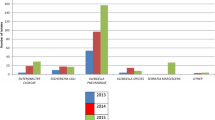Abstract
Background:
To study risk factors of neonatal nosocomial infection caused by extended-spectrum beta-lactamase (ESBL)-producing bacteria in a neonatal intensive care unit (NICU).
Patients and Methods:
A retrospective cohort study was conducted in a university hospital NICU in south China. Medical records of neonatal nosocomial infection caused by Escherichia coli or Klebsiella pneumoniae were reviewed. Twenty-two neonates infected with ESBL-producing bacteria (case patients) were compared with 17 patients infected with non-ESBL producing strains (controls). Univariable and multivariable logistic regression were performed to analyze risk factors for infection with ESBL-producing strains. The spectrum of antimicrobial resistance of ESBL-positive E. coli or K. pneumoniae was also examined.
Results:
Both univariable and multivariable logistic regression analysis revealed that preterm low birth weight, prolonged mechanical ventilation (≥ 7 days) and prior use of third-generation cephalosporins were risks factors for ESBL-producing E. coli or K. pneumoniae infection (p < 0.05), with an odd ratio of 6.43 (95% CI: 1.51–27.44; p = 0.017), 7.50 (95% CI: 1.38–40.88; p = 0.017) and 9.00 (95% CI: 1.65–49.14; p = 0.008) respectively. However, the length of hospital stay before isolation of pathogens, endotracheal intubation, presence of a central venous catheter, days on third-generation cephalosporins and prior use of beta-lactamase inhibitors were not statistically significant (p > 0.05). Resistance of ESBL-positive strains to piperacillin, tobramycin, aztreonam and cephalosporins was significantly higher than that of ESBL-negative ones (p < 0.05). ESBL-producing strains appeared susceptible to carbapenem, fluoroquinolones, and beta-lactamase inhibitor combination piperacillin-tazobactam.
Conclusions:
Preterm low birth weight, prolonged mechanical ventilation and prior use of third-generation cephalosporins are risks factors for nosocomial infection with ESBL-producing bacteria in NICU.
Similar content being viewed by others

Author information
Authors and Affiliations
Corresponding author
Rights and permissions
About this article
Cite this article
Huang, Y., Zhuang, S. & Du, M. Risk Factors of Nosocomial Infection with Extended-Spectrum Beta-Lactamase-Producing Bacteria in a Neonatal Intensive Care Unit in China. Infection 35, 339–345 (2007). https://doi.org/10.1007/s15010-007-6356-9
Received:
Accepted:
Published:
Issue Date:
DOI: https://doi.org/10.1007/s15010-007-6356-9


